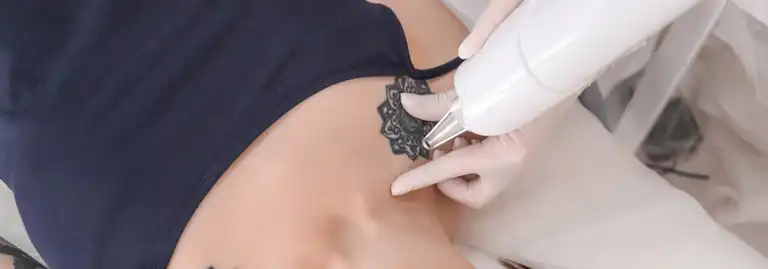
Everything You Should Know About Modern Tattoo Removal Methods In Reputed Laser Clinics!
Nowadays, people do tattooing as fashion statement, sentimental reasons, religious, and emotional decision, no doubt that the popularity of tattoo is now growing rapidly. Tattoos are done by inserting coloured ink into the skin. Tattoos are fashionable at teenage but the same tattoo is inappropriate at the time of searching jobs. So with the changed emotions and situations people regret of their tattoos and want to be removed permanently; because of relationship failures, college mistakes or religious communities do not allow in their places.
Tattoos are created by inserting permanent coloured materials into the skin or accidental entry of pigmented material.
Tattoo inks consist of pigments combined with a carrier, and are used in tattooing.
Tattoo Ink consists of pigments combined with a carrier, and are used in tattooing.
Tattoo inks are available in a range of colours that can be thinned or mixed together to produce other colours and shades.
In older days amateur tattoo inks consist of simple, carbon particles originating from burnt wood, cotton, plastic, or paper, or from a variety of inks, including Indian ink, pen ink, and vegetable matter. Along with Indian ink, the classic tattoo dye, formerly used substances include heavy metals such as mercury(red), lead(yellow, green, white) cadmium (yellow), chromium (green), cobalt (blue) and iron (brown, red, black). Moreover recently, instead of these metal salts, high-quality industrially manufactured organic chemical pigments are used such as azo-chemicals, naptha-derived chemical, polycyclic pigments of the phthalocyanine and even pigments of automobile paints are also used.
Tattoo ink is generally permanent. Tattoo removal is difficult, painful, and the degree of success depends on the materials used.
In previous days few traditional methods are used to remove unwanted tattoo:
Though not proven to be effective, if you wish to go natural, you can try using lemon and honey, apricot scrubs, salt scrubs, chemical peels, etc to remove tattoos and then it is unlikely to respond. These methods have their own limitations, side effects and may leave a scar (hypertrophic or keloid) that is more difficult to treat than the tattoo itself.
Laser Tattoo Removal: Laser treatment is often safer than many other tattoo removal methods, as laser treatment selectively treats the pigment in the tattoo with very minimal side effects. Especially Nd:YAG Laser is the tool of choice for most tattoo removal practitioners.
Q-switch lasers are considered as gold standard laser technology for tattoo removal
This is most commonly used in parlours and beauty salons. Though cheaper, these passive lasers can only partially remove the tattoo, and cannot guarantee complete removal.
This is expensive, but the most effective and efficient way of completely removing tattoos of almost every color. The active Q-switched laser is the gold standard in removing tattoos, they are of three types:
The laser is the best, the easiest, and the most commonly used method for tattoo removal.
Tattoo ink or pigment absorbs the light without destroying the normal surrounding skin tissue. The tattoo ink or pigment break down into small particles and then removed by the body’s own immune system. After a series of treatment sessions, the tattoo particles are broken up enough to no longer be visible.
It works on the theory of ‘selective photothermolysis’, which states that when the appropriate wavelength of light and pulse width is equal to or shorter than the target’s thermal relaxation time, the heat generated will be confined to the target. While most of these lasers operate on nanosecond, the newer pico second pulse duration lasers remove tattoos by a photomechanical effect as well, that is by physically fracturing the tattoo particles
The ink colour (black is the easiest colour to treat because it absorbs all laser wavelengths while green, yellow, and fluorescent inks are notoriously difficult to remove)
Amateur or professional tattoos (overall, amateur ones are easier to remove)
The age of the tattoo (older days tattoos are easier)
The location on the body (on the extremities are difficult to treat since the circulation is relatively poor; closer it is to the heart, better are the results of removal)
The colour tattoos respond well to KTP lasers such as ruby and alexandrite laser work better than Nd:YAG laser.
The energy should be sufficient enough to break the specific colored ink pigment into pieces
The time duration of laser energy must be very short, such that the tattoo is heated enough to fragment, but not so much that the particles dissipate into surrounding skin and the new pico lasers have photomechanical effect to fragment the ink by physical means.
In fact, for most people, the sensation of removal is comparable to the procedure of insertion of ink during tattooing. It is commonly described as the sensation of being snapped by a rubber band.
Moreover you need to visit most reputed and reliable advance laser centre nearby which offers high standard services.
To hasten the healing of skin, avoid side effect, and to facilitate speedy tattoo removal process, follow aftercare instructions:
Clear Skin Hair and Laser Centre equipped with world’s most advanced US FDA approved laser technologies. We are committed to remove tattoo completely or up to 98% removal of all types of tattoos. At Clear Skin Hair and Laser Centre we use Gold standard laser for Unwanted Tattoo Removal, Nd:YAG AND Pico Laser.
